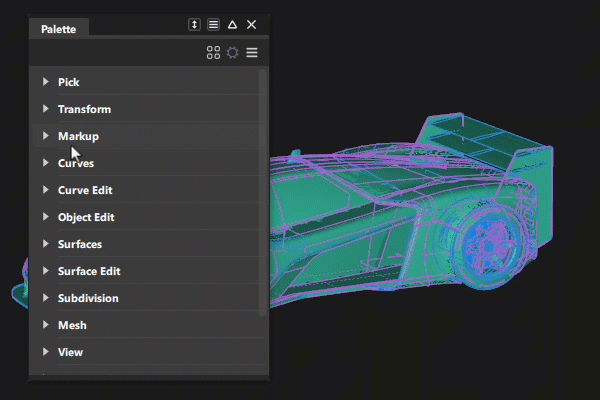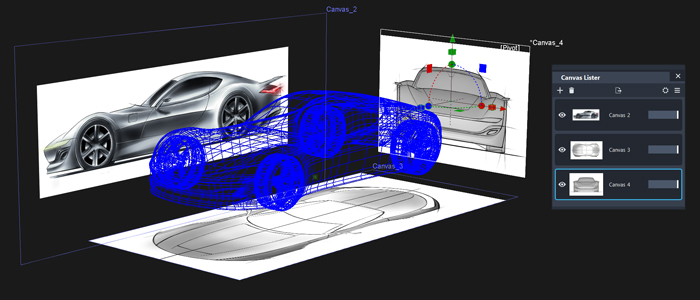Markup palette
![]() +
+ ![]()
The Markup Tool Palette contains several simple drawing tools to create sketch annotations and drawings. Markups let you draw directly onto the camera view, making it easy to share feedback on design projects.

Access the Markup brushes from the Markup tool palette:

When using a Markup brush, if no markup is currently active, it creates one on the current view. Rotate the view to exit the active Markup when you are finished drawing. Markups are automatically saved and can be accessed in the Markup Lister.
When drawing, use:
- LMB + drag to draw freehand lines
- MMB + drag to draw horizontal lines
- RMB + drag to draw vertical lines.
Markup brushes
The Markup tool palette provides the following brushes:
 Pencil
Pencil
Applies pencil strokes to the active Markup.
 Pen
Pen
Applies a uniform pen stroke to the active Markup.
 Brush
Brush
Applies a tapered brush stroke to the active Markup.
 Air Brush
Air Brush
Applies air brush strokes to the active Markup.
 Soft Eraser
Soft Eraser
Erases the stroke from the active Markup using a soft edge.
 Hard Eraser
Hard Eraser
Erases the stroke from the active Markup using a hard edge.
 Text Markup
Text Markup
Allows you to add text to your Markups. The tool offers various options for font, size, and style.
Markup tool options
Drawing Brush Options
Brush Color
Selecting the color chip will open up the Color Editor window. The slider controls the lightness of the color.
Brush Radius
The radius of the brush (measured in pixels) when you press the stylus lightly against the tablet. The valid range is 0 - 1024.
Brush Opacity
Controls the translucency of the brush color. If Brush Opacity is less than 1, and you sketch several times in the same spot, the paint will build up (for erasers, the amount of paint removed will build up) and become more opaque. The valid range is 0 (entirely clear and invisible) to 1 (entirely opaque).
Predictive Stroke
![]()
Turn this on to improve the quality of your strokes by making them more uniform and smooth. It's especially useful when drawing straight lines, circles, or ellipses, and when drawing quickly using a mouse.
Predictive Strength
![]()
When Predictive Stroke is on, use the Predictive Strength slider to set how much you want your stroke to be smoothed. The higher the number, the smoother the stroke and the better the shape recognition.
Text Markup Options
![]()
Font - Select a font for the text.
Text Color - Selecting the color chip will open up the Color Editor window. The slider controls the lightness of the color.
Style - Select a style (Regular, Bold, Italic) for the text. Options will vary for each font.
Point Size - Sets the text size. The default value is 1.
Tracking - Adjusts the space between characters.
Markup tool workflows
By default, the size of the Markup created is based on the width and height of the window. This can be changed in the Preferences > General Preferences > Markup.
Create a markup using a brush
Choose a brush from the Markup Palette.
The first time you click on top of the current view creates a Markup based on that view. You can now begin drawing freely.
When drawing, use:
LMB + drag to draw freehand lines
MMB + drag to draw horizontal lines
RMB + drag to draw vertical lines.
Tip: Turn on Predictive Stroke to draw smoother more uniform lines. Adjust Predictive Strength to set how much you want your stroke to be smoothed.
- To exit the current Markup and finish drawing on that Markup, rotate the view.
Create a text markup
![]()
- Choose the Text Markup tool from the Markup Palette.
- The first time you click on top of the current view creates a Markup based on that view. Click again in the window and type to add text to the Markup.
- To modify the text object, use the Text Options to define the font, color, and style of the entire text object.
- To move the text object, click and drag on the outline of the text then position it where you would like.
- Click somewhere else in the view window to add another text object on the same markup, then use the Move to Front, Move Forward, Send Backward, and Move to Back options in the bottom right of the view window to organize how the text is displayed.
- To delete an individual text object, press the
Deletekey.
Work with the Markup Lister
Open the Markup Lister in Windows > Markup Lister.
Click the
 icon.
icon. This creates a new markup based on the current view. You can now beging drawing freely.
To exit the current Markup and finish drawing on that Markup, rotate the view.
Images as Canvas

Images can be imported as a canvas which lets you place and transform them as planes. This is useful for setting up reference images that need to exist in the scene.
Import through file menu
- Select File > Import > Canvas.
- Choose an image using the file browser.
- The image is placed facing the camera and can now be transformed.
Import through Canvas Lister
- Open the Canvas Lister by choosing in Window > Canvas Lister.
- Click the
 icon to open the file browser and choose an image.
icon to open the file browser and choose an image. - The image is placed facing the camera and can now be transformed.
